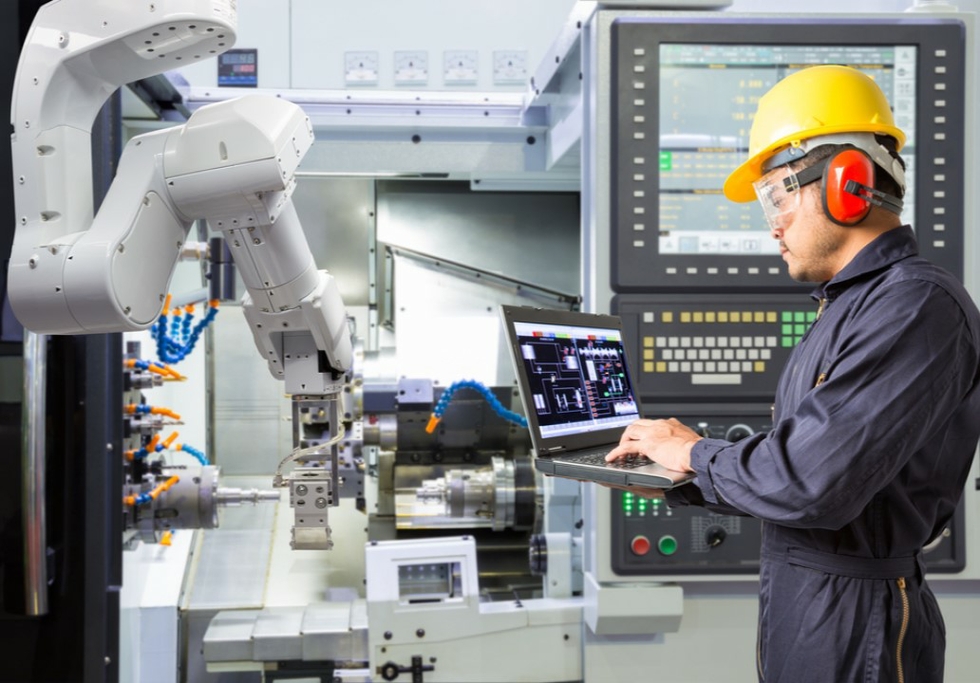Benefits of robots in manufacturing

The World Robotics Report 2021 shows that the number of robots per 10,000 employees rose from 66 to 126 globally between 2015 and 2020. So, which sectors are reaping the rewards?
Here, we’ll explore them, shining a light on the industries that are benefiting the most from robotics.
Manufacturing
The nature of manufacturing has changed significantly in recent years, largely due to COVID-19. In fact, North American companies purchased 11,595 robots in the first quarter of 2022. This record-breaking figure amounted to a staggering $646 million.
Robotics has many benefits for the industry, from improved accuracy to reduced packaging time.’ Kroger, the largest supermarket chain in North America, uses $55 million worth of robots in its warehouses. These robots help efficiently package a variety of groceries, such as grains and vegetables.
In the U.K. automotive manufacturing industry, these robots are increasing in number, with about 875, accounting for 16 percent of the robots installed in 2020. Due to a lack of workers, some industries are seeing the benefits of robot applications, including the food and beverage industry, which already uses industrial machinery and hydraulic cylinders, and has increased to 304 robots in 2020. This is a 96% increase in numbers since the previous year.
Healthcare
Innovations in robotics have many uses in healthcare, ultimately improving the services patients receive. Assistive robots can deliver goods, such as life-changing medications, in hospitals when nurses are understaffed or busy. These robots can also disinfect hospital rooms and other areas using UV-C lighting.
Scientists are also working to create microbots – robots expected to be as small as a human cell. These robots may be able to travel through a patient’s body and help repair it. They may also replace the need for some prescription drugs. As a result, microbots could revolutionize health care delivery around the world.
Battery manufacturing
The battery manufacturing sector benefits from the use of robotics. Companies that manufacture the batteries used within battery packs are incorporating robotics into their business operations. This is used in the manufacture and in-process transportation of products and materials.
However, Alex Stapleton, director of sales for Alexander Technologies, a leading supplier of custom lithium-ion batteries and chargers, notes that robotics is also often driven by battery packs.
“While some robotic solutions are stationary, such as robotic arms on production lines, many others are small vehicles that are not stationary and are used for the purpose of transporting goods and components. These may be AGVs (Automated Guided Vehicles) or AMRs (Autonomous Mobile Robots) and come in a variety of forms, such as pallet shuttles, mobile platforms, carts and forklifts. In large, busy logistics operations, robots reduce labor costs, can operate around the clock, and because they are computer-controlled, can increase picking accuracy to 100% without human error. “
Agricultural robotics is also growing. This allows farms and farmers to reduce the overhead of repetitive activities such as seeding, weeding, picking and feeding. It also uses artificial intelligence combined with cameras to monitor crop growth and development, determining exactly when crops are ready for harvest and even harvesting individual plants at the optimal moment.
“Thoughtfully designed, the rugged lithium-ion battery pack gives these applications enough energy to run for long periods of time. The same technology means that robots can be recharged very quickly and redeployed with minimal downtime. Logistics robots are impossible without batteries, as warehouses need to be zero-emission environments. Likewise, agricultural robots can be deployed in the field, supported by solar panel installations, which means no grid connection is required to make the transition.”
Education
Robotics is also very beneficial in the education system. From elementary school to higher education, teachers and learning professionals are able to use robotics to help students in the classroom. There is currently a robot designed to communicate with children and ask logical questions.
Not only will this be beneficial to students, but these robots will help teachers as class sizes continue to grow. The future of robotics in education also appears to be bright. British education expert Anthony Shelton believes that these robots will replace teachers as the main educational leaders. So teachers could become assistants in the future.
There is no limit to what robotics can be used for. Scientists will continue to innovate and create new technologies beyond our wildest dreams, which will prove vital to advancing your industry. If these are the machines of today, we can only imagine what tomorrow will bring.
Related recommendations
-
Mobile Robot Technology
909Are you looking for ways to start your company's robot development? Or are you already developing robots and looking for ways to make them smarter?...
View details -
Warehouse risks and preventive measures
546What are the rules and procedures for proper safety management in the warehouse? How to protect health and prevent accidents and injuries in the wo...
View details -
Google robot autonomous dialogue
1566In early November, Google, for the first time, released an internally developed software tool that reduces the amount of work required to train rob...
View details -
International industrial robot technology is becoming increasingly mature
1739The future of automation depends on collaboration between manufacturers, partners and distributors to create applications that are integrated, acce...
View details
 Plutools
Plutools



HelloPlease log in